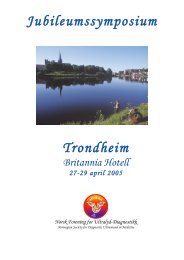Ultralydsymposium - NORSK FORENING FOR ULTRALYD ...
Ultralydsymposium - NORSK FORENING FOR ULTRALYD ...
Ultralydsymposium - NORSK FORENING FOR ULTRALYD ...
- No tags were found...
Create successful ePaper yourself
Turn your PDF publications into a flip-book with our unique Google optimized e-Paper software.
CEUS in Benign and Malignant Liver LesionsODD HELGE GILJA National Centre for Ultrasound in Gastroenterology, Department of Medicine,Haukeland University Hospital, and Institute of Medicine, University of Bergen, Bergen, NorwayThe role of US in the characterisation of focal liver lesions has been transformed with the introductionof specific contrast media and the development of specialized imaging techniques. Ultrasound nowcan fully characterise the enhancement pattern of hepatic lesions, similar to that achieved withcontrast enhanced multiphasic computed tomography (CT) and magnetic resonance imaging (MRI).US contrast agents are safe, well-tolerated and have very few contraindications. Furthermore, realtimeevaluation of the vascularity of focal liver lesions has become possible with the use of novelmicrobubble contrast agents and advanced post-processing tools for detailed perfusion analysis.Three contrast phases can be differentiated due to the specific blood supply of the liver: First, thearterial phase (hepatic artery) starts 10 to 20 seconds after intravenous injection and lasts for 10 to 15seconds. Second, the venous phase (portal vein) extends from 30 to 35 seconds and lasts up to 120seconds. Third, the late phase starts at 120 seconds and lasts up to five minutes post-injection with thegradual disappearance of bubbles.CEUS patterns seen in common benign hepatic lesionsHemangiomas have a peripheral globular contrast pooling in the early phase (a cotton woolappearance), with the globules becoming larger and more numerous (centripetal fill-in).Nicolau (2004) showed the frequency and percentage of focal liver lesions correctly classified ashemangiomas in the vascular and late phases. By typical contrast-enhancement patterns, 19 of 22hemangiomas could be correctly identified in the late phase (86.4%) and 18 in the vascular phase(81.8%). Ding (2005) showed sensitivity of 96.3% and specificity of 97.5% when centripetal fill-inenhancement was regarded as a positive finding of hemangioma.Focal nodular hyperplasia has a centrifugal stellate branching in early arterial phase followedby an intense homogenous uptake (spoke wheel pattern). Rapid washout occurs thereafter and an isoorhyperechoic lesion is seen in portal venous phase. When these characteristic features are regardedas positive findings of FNH, the sensitivity and specificity of contrast-enhanced low MI real-time USare 87.6% and 94.5%, respectively (Di Stasi 1996).Liver cell adenoma (LCA) is a rare primary benign neoplasm found mainly in young womenwith a history of oral contraceptive use, androgen steroid therapy or in patients with glycogen-storagedisease. By using a continuous low-MI imaging, CEUS with SonoVue allows the identification of thevery early and homogeneous hyperechoic enhancement in the periphery of the tumor, reflecting thepresence of the subcapsular feeding arteries. The enhancement of LCA in the portal and late phases isnearly comparable with that of liver parenchyma, but LCA can remain slightly hypoechoic in relationto the adjacent liver.CEUS patterns seen in common malignant hepatic lesionsThe most common malignancy of the liver is metastases. Unenhanced US achieves asensitivity between 45 and 80 % in detecting liver metastases. However, the application of an iv. UScontrast agent during transcutaneous US of the liver improves detection of metastases significantly.Differentiation of hyper- from hypovascular metastases is achieved perfectly by real-time imagingduring the arterial phaseHepatocellular carcinoma (HCC) is the second common malignant liver tumor and the mostcommon primary liver cancer. On grey scale sonography, HCCs may be hypo (26%), hyperechoic(13%) or have mixed (61%) echogenicity depending on the size of the tumor, the fat content, degreeof differentiation and scarring of necrosis. When CEUS is applied, HCCs are typically characterizedby hypervascularity in the arterial phase. Arterial enhancement may be inhomogeneous, because thetumor contains septa, regions of different tissue differentiation and shunting among the neo-formedvessels, and sometimes necrosis.Reference: Postema M, Gilja OH. Contrast-enhanced and targeted ultrasound. World J Gastroenterol2011;7(1):28-41.











